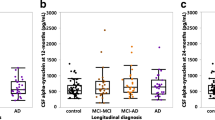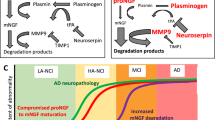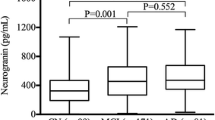Summary.
Nitric oxide (NO) may play a role in the pathophysiology of Alzheimer's disease (AD). Asymmetric dimethylarginine (ADMA), an endogenous inhibitor of NO synthase, is involved in regulation of NO production. Recently it has been reported that dimethylarginine dimethylaminohydrolase, an enzyme that hydrolyses ADMA into citrulline and dimethylamine, is specifically elevated in neurons displaying cytoskeletal abnormalities and oxidative stress in AD. We hypothesized that this could lead to altered CSF concentrations of ADMA in AD. Measurement of ADMA and dimethylamine in CSF revealed no significant differences between AD patients (n = 20) and age-matched control subjects (n = 20). Our results suggest that in early stages of AD overall regulation of NO production by ADMA is not aberrant.
Similar content being viewed by others
Author information
Authors and Affiliations
Additional information
Received March 14, 2002; accepted May 21, 2002 Published online July 26, 2002
Rights and permissions
About this article
Cite this article
Mulder, C., Wahlund, LO., Blomberg, M. et al. Alzheimer's disease is not associated with altered concentrations of the nitric oxide synthase inhibitor asymmetric dimethylarginine in cerebrospinal fluid. J Neural Transm 109, 1203–1208 (2002). https://doi.org/10.1007/s00702-002-0760-1
Issue Date:
DOI: https://doi.org/10.1007/s00702-002-0760-1




